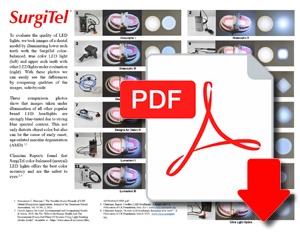Review of a Recent Article: “The Potential ‘Blue Light Hazard’ from LED Headlamps”

ErgoPractice News – August 2022
By Jin Chang PhD
jchang@surgitel.com
Summary
In August 2022, this article was published virtually in advance of its October 2022 printed version in Volume 125 as Article 104226 by Elsevier: Journal of Dentistry. Having read the article, I have found that it may be very useful to both researchers and practitioners. Therefore, I would like to introduce this excellent article: “The Potential ‘Blue Light Hazard’ from LED Headlamps” by Richard B. Price, Daniel Labrie, Braden Sullivan, and David H. Sliney. This article reviewed 74 reference articles about the potential blue light hazard with various electronic devices and clinical headlamps which use artificial LED lights and evaluated six (6) popular LED headlamps plus one halogen headlamp for dental professionals. If you are interested in studying retinal blue light hazards associated with LED headlamps, you should read this article.
“The Potential ‘Blue Light Hazard’ from LED Headlamps” can be downloaded for free until September 29, 2022. After September 29, 2022, there will be a charge for each copy of the article. Click Here to view the article.
LED Headlamps Evaluated
This article evaluated six (6) LED headlamps and used a SurgiTel halogen headlamp as a reference. Please note that SurgiTel’s halogen headlamp was the first portable headlamp operated with a battery pack. SurgiTel halogen headlamps made with mini halogen bulbs at 3114 Kelvin (K) were introduced in the early 1990s and were well accepted by clinicians. However, halogen headlamps were discontinued because the production of mini halogen bulbs ended as LED lights became popular. SurgiTel replaced halogen headlamps with LED headlamps.
The six (6) LED headlamps that were evaluated: SurgiTel warm (3098K), SurgiTel neutral (4138K), SurgiTel cool (6283K), Q-Optics (6449K), LumaDent (7065K) which was sold as warm, and Orascoptic Spark (7253K). It is noted that the color temperatures of the beams were measured by the evaluation team. In general, the color temperatures of the beams are different from the color temperature of LED chips. All other brands of LED lights that are not included in this article are cool and their color temperatures are between 6000K and 9000K which were measured by other evaluators.1-3
Methods in Evaluating Headlamps
Spectral radiant powers were measured using an integrating sphere (with an aperture of 1.53 cm) attached to a fiber optic spectrometer. Spectral radiant powers were measured both directly and indirectly at a distance of 35 cm, and the maximum daily exposure times were calculated from the blue weighted irradiance values.
Comment: The integrating sphere with a fixed aperture may be too simple as a model of the eyes because the pupil size varies according to the brightness of objects. However, this study provides us with interesting data. I suggest that in the future authors may use an integrating sphere with varying apertures according to the peak of the green/red band of LED light because the eyes do not register the blue light as hazardous and therefore do not restrict the pupil accordingly. The human eye does not react well to the peak of blue light from white light LED sources because human eyes are only about 5% as responsive to blue light between 440 nm and 450 nm.
Conclusions by Authors
- The color temperatures (K), radiant powers, and emission spectra from the headlamps tested were all very different and did not all deliver a similar ‘blue light hazard.’
- Among the six (6) LED-based headlamps tested in this study, the SurgiTel warm headlamp emitted a high luminous power of 98 lumens (lm) at 3098K. It offered the longest cumulative daily exposure time (tmax) of 205 s when viewed directly at a distance of 35 cm. The LumaDent headlamp also emitted a high luminous power of 115 lm, but this was cool-white light at 7253K. The maximum cumulative exposure time (tmax) from this lamp was only 53 s when viewed at a distance of 35 cm.
Comment: It is noted that the authors found that the tmax (53 s) of the LumaDent LED headlamp is shorter than tmax (62 s) of the LED curing light. It is noted that the LumaDent cool-white LED was sold as the warm LED light. Many LED headlamps may create more potential blue light hazard than LED curing lights.
- Patients should wear eyewear that specifically blocks out blue light.
Comment: I suggest that patients wear eyewear that blocks all light because the focused beam of a LED may burn the retina of patients. Personally, I close my eyes when the treatment starts.
- Indirect viewing at a distance of 35 cm of the reflected light from LED headlamps did not exceed the cumulative exposure time (tmax) for healthy adults in an 8-hour day.
Comment: This conclusion is based on the measurement with the integrating sphere with a fixed aperture and the current safety limit determined by the International Commission on Illumination. However, the pupil size of the eyes varies in order to allow the optimum amount of light to reach the retina and the blue light hazard safety limit may be reduced. It is noted that not only cool LED headlamps may create a potential blue light hazard but also distort the color of images. Either warm or neutral LED headlamps are the best for dental applications.
- Using a blue color dental dam increased the hazard and decreased the maximum cumulative daily exposure time, but tmax was still greater than 24 hours.
Why Choose SurgiTel as Your Partner for Vision Aid Products?
The founding mission of SurgiTel has been to help clinicians practice dentistry and surgery safely by providing posture-safe ergonomic loupes and eye-safe LED headlights. As a result of continuous research and development during the last 30 years, SurgiTel can make all types of posture-safe ergonomic loupes (FLM type, straight TTL type, and deflection TTL type) for all clinicians with different facial features and offer the full range of LED headlights (warm LED, neutral LED, and cool LED) that provide the best color accuracy and are safest for the eyes. Warm and neutral LEDs are used primarily for dental professionals and cool LEDs for surgical applications.
SurgiTel’s free evaluation service can help assess your working posture and identify potential blue light hazards of various brands of LED lights. Click Here to schedule a free evaluation.
Click here to receive the full light comparison chart.
References
- “Smaller and Lighter LED Headlamps.” Clinicians Report 5, no. 4 (April 2012): 1, 6. https://www.cliniciansreport.org/products/dental-reports/products-real-world-practitioners-use-and-value-most-april-2012-volume-5-issue-4.
- “Is Your LED Headlamp Damaging Your Eyes?” Clinicians Report 6, no. 3 (March 2013): 1, 3. https://www.cliniciansreport.org/products/dental-reports/march-2013-is-your-led-headlamp-damaging-your-eyes-cordless-gingival-retraction.
- “Cordless LED Headlamps: A Bright Idea?” Clinicians Report 10, no. 5 (May 2017): 1–2. https://www.cliniciansreport.org/products/dental-reports/cordless-led-headlamps-a-bright-idea-wipe-disinfection-killing-or-spreading-the-germs-radiation-are-you-and-your-patients-and-staff-protected-%E2%80%93-may-2017-volume-10-issue-5.




